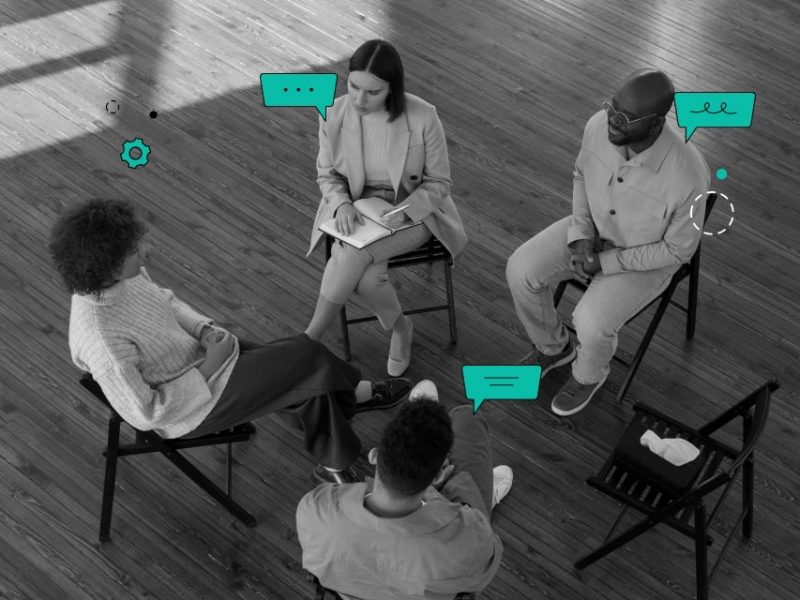Understanding markets, audience preferences, and consumer behaviors is the lifeblood of successful enterprises and creators. When it comes to market research methods, focus groups are considered versatile forumս, where the voice of the audience echoes in ways that pure data and analytics often struggle to achieve. But how objective can they be? Where do they fall short? And finally, is there a more accurate barometer that can predict a person’s intent to buy?
This comprehensive guide to focus group testing will help business owners and creators harness the power of these focus groups where possible, as well as cue them into the other mind-boggling indicators that will provide the richest marketing insight.
What are Focus Groups?
At its core, a focus group is a qualitative research technique that brings together a diverse set of individuals to discuss and deliberate on a particular topic under the guidance of a moderator.
Unlike other survey methods, focus group research encourages interaction, dialogue, and exploration of ideas among group members, providing a richer context to the topics being researched.
Here are some examples of ways focus groups can be used:
Example 1: Testing a New Product
Imagine a brand is launching a new line of athletic apparel designed for active lifestyles. In a focus group, teenagers aged 15-18 could provide invaluable insights into the appeal, functionality, and marketability of these clothes.
Potential Questions:
- What are your first impressions of this clothing?
- How comfortable and functional do you find it?
- Would you wear this for your preferred activities?
- What improvements could be made to the design or features?
Example 2: Developing a Community Health Initiative
Senior citizens living in a specific neighborhood can participate in a focus group aimed at addressing health concerns and access to resources for older adults.
Potential Questions:
- What are the biggest health challenges you face in your community?
- What resources are currently available, and what gaps exist?
- What kind of initiative would be most helpful to improve your health and well-being?
- How can we ensure this program is accessible and inclusive for all seniors?
Example 3: Evaluating a Social Media Campaign
Young professionals aged 25-35 are brought together to evaluate a recent campaign promoting financial literacy on social media.
Potential Questions:
- Did you see the campaign, and if so, what platforms did you see it on?
- Did the campaign resonate with you and why or why not?
- What information did you find most valuable or helpful?
- How could the campaign be improved to reach and engage this audience more effectively?
One other arena win which you may have heard of focus groups being used is in politics. Politicians running of office, will have a team of people around them who help them craft their message and agenda – and among them are pollsters, i.e. those who conduct polls. Focus groups are expensive and not used that often, but when fine-tuning the message this tool can be very helpful.
The Pros and Cons of Focus Groups
Understanding both the strengths and limitations of focus group research is critical for shaping realistic expectations and effective methodologies. Focus groups, like any research method, have their place but may not be the silver bullet for every situation.
Advantages of Focus Groups
- In-Depth Insights: They allow for more in-depth exploration of consumer perceptions, providing context that is often missed in surveys.
Unlike surveys which can restrict responses to predefined options, focus group testing affords participants the freedom to express their views comprehensively. This leads to the uncovering of thought processes and context that surveys may miss, giving businesses a thorough understanding of their target market.
- Interactive Setting: The group dynamic can lead to the emergence of new ideas and more profound insights.
This group dynamic can result in the surfacing of new ideas that may not have been brought up in an individual setting. This synergy can uncover profound insights that can be pivotal for a business’ decision-making process.
Disadvantages of Focus Groups
- Expensive: The reality of focus groups is that they are very expensive.
If you’re a multinational brand and want to understand the global view, you have to organize focus groups in various countries. This ends up being very costly and can easily cost 6 figures for a comprehensive research.
- Timing: Focus groups take a pretty long time to plan
The logistics that focus groups entail make both organizing and the proces of data analysis very time consuming. In addition, focus groups aren’t interactive, making it impossible to go back and ask “what if” type of questions.
- Potential for Biases: The group setting can amplify individual biases or groupthink, leading to skewed results. There is also a tendency to be more optimistic.
In a group setting, individual opinions can get amplified or suppressed, leading to skewed findings. The danger of groupthink, where people align their opinions with what they perceive as the consensus, may lead to a lack of diverse perspectives.
Another point of concern is the tendency to be more optimistic as people receive monetary incentives for their opinions. This means they tend to be more biased towards providing good answers to not discourage the brand.
- Moderator Influence: The skills and biases of the moderator can disproportionately influence the group discussions.
A skilled moderator ensures that the discussion stays on track and every participant gets an opportunity to voice their opinion. However, if the moderator has a conscious or unconscious bias, they may disproportionately steer the discussion in a certain direction, potentially leading to biased results.
- Lack of Generalizability: Findings from focus groups may not be statistically significant or representative of a broader population.
They typically involve a small number of individuals who may not represent the broader population accurately. Therefore, the insights garnered from focus groups may not be generalizable to a wider audience, limiting their effectiveness in making larger-scale business decisions.
- The Hawthorne Effect: This is the idea that the behavior of those being observed changes because of a specific intervention [such as the act of being observed itself]
Can you really be sure the answers you’re getting are coming from a place of truth? The short answer is, no. No matter what instructions respondents receive from the moderator or how much money they may be paid for participating, groupthink is not the only form of bias or dishonesty you encounter. While participants of a focus group have agreed to answer a set of questions everything from what they say to how they carry themselves could give off false clues.
Oftentimes, people want to sound more helpful, more politically correct, more moderate, more sophisticated, and/or more intelligent than they actually are. This form of masquerading within the psychology of participants is something that’s incredibly hard to pick up on. Yet it can once again scew the results of focus group research.
🧐 Looking for deeper, more unbiased insights?
Traditional focus groups can be costly and prone to biases. With Prelaunch’s In-Depth Interviews, you can directly connect with real potential customers, ask tailored questions, and gather genuine, purchase-driven feedback—all without the limitations of a group setting.
How to Conduct a Focus Group
Executing a successful focus group requires thoughtful preparation, from crafting the right questions to managing logistics. Here are the steps you should follow to conduct an impactful focus group testing session.
What Questions to Ask to Focus Group Participants
Effective focus group questions are open-ended, encouraging participants to share their experiences and opinions without leading them to a specific answer. Questions must be tailored to the research goals and the profile of participants.
Craft Questions for Specific Aims
Each question should serve a specific purpose, whether to uncover pain points, preferences, or unmet needs. Here are examples of different types of questions:
- General Questions: Openers to set the stage and get participants talking.
E.g. Could you tell us a bit about your experience with our product?
- Specific Questions: To explore the central themes of your research.
E.g How has the user interface of our software impacted your daily workflow?
- Probing Questions: To dig deeper into comments or responses that merit further exploration.
E.g. Could you elaborate on how you felt the customer service team could have improved their support?
- Closing Questions: To ensure participants have shared all relevant information.
E.g. Is there anything else you would like to share about your experience with our service?
How to Craft Impactful and Effective Focus Group Questions
In reality, asking questions is the easy part. There’s a bunch of homework that needs to be done in advance. Here are some key principles to help you craft good questions for focus group participants:
Open-ended and flexible:
- Avoid “yes” or “no” questions. Instead, use “why” and “how” to encourage detailed and nuanced responses.
Example: Instead of: “Do you like this product?” Ask: “What are your thoughts and feelings about this product?”
Unambiguous and clear:
- Use simple language that everyone in the group can understand.
- Avoid jargon or technical terms that might be confusing.
- Be specific enough to guide the discussion, but broad enough to allow for diverse perspectives.
Example: Instead of: “What do you think of the website?” Ask: “What are your initial impressions of the website’s design and ease of use?”
Neutral and unbiased:
- Avoid phrasing that suggests a preferred answer or leads participants in a specific direction.
- Present opposing viewpoints fairly and avoid injecting your personal opinions.
Example: Instead of: “This app is the best on the market, right?” Ask: “What are the strengths and weaknesses of this app compared to similar applications?”
Focus on behavior and experiences:
- Encourage participants to share their personal experiences and past behaviors related to the topic.
- This provides deeper and richer insights compared to hypothetical scenarios.
Example: Instead of: “Would you use this service in the future?” Ask: “Can you tell us about a time when you used a similar service and what made the experience positive or negative?”
Consider the sequence of your questions:
- Start with broad, introductory questions to warm up participants and encourage them to share openly.
- Gradually move towards more specific and probing questions as the discussion progresses.
- End with open-ended questions to allow for final thoughts and any lingering concerns.
Additional tips:
- Pilot test your questions: Try them out with a small group beforehand to assess clarity and effectiveness.
- Allow for silence: Don’t pressure participants to answer immediately. Give them time to think and formulate their responses.
- Actively listen: Pay close attention to verbal and nonverbal cues to understand the full meaning behind participants’ responses.
- Be flexible: Adapt your questions as needed based on the flow of the conversation and emerging themes.
Focus Group Research Best Practices
1. Define clear objectives and recruit relevant participants:
Example: A restaurant chain wants to revamp its menu. They recruit a focus group of young professionals who frequent fast-casual restaurants to understand their preferences and identify potential menu items that resonate with this demographic.
2. Create a comfortable and inclusive environment:
Example: The restaurant chain holds the focus group in a relaxed setting, providing refreshments and ensuring everyone feels welcome to share their opinions.
3. Develop a well-structured discussion guide with open-ended questions:
Example: Instead of asking “Do you like our new burger?”, they ask “What are your thoughts on the taste, texture, and overall presentation of the new burger?” and “How does this burger compare to similar options you’ve tried elsewhere?”
4. Facilitate the discussion effectively:
Example: A professional moderator guides the conversation, ensuring everyone has a chance to contribute, actively listens, and probes for deeper insights without leading the discussion or expressing personal opinions.
5. Record
Catching every phrase, nudge and twitch can be tough. This is where recording comes in handy. Use both audio and video recordings to capture the session, but always ask for participant consent. Then, transcribe and analyze the data, looking not just at what is said but how and why it is said.
6. Analyze and report the findings:
- Example: After the focus group, the restaurant chain analyzes the transcripts, identifying common themes and preferences expressed by participants. They use this information to refine their menu and tailor offerings to better cater to the target audience.
Additional best practices:
- Offer incentives to participants for their time and contribution.
- Maintain confidentiality of individual responses.
- Thank participants for their participation.
By following these best practices and considering the real-life examples, you can ensure your focus groups are productive, insightful, and provide valuable data for your research or project.
How to Eliminate Bias
Biases are often an unseen and unwanted participant in focus group discussions. But eliminating them is not as easy as striking a juror during voir dire (jury selection). To mitigate this, moderators must strive for neutrality and focus on the process. And while eliminating bias completely is impossible, there are several strategies to minimize its influence in your focus groups. To keep you organized we’ve organized our list of tipe into things you can do before, during and after your focus group session.
Before the Focus Group:
- Recruit a diverse group: Aim for a wide range of demographics, backgrounds, and viewpoints relevant to your research topic. Avoid homogeneity, which can lead to groupthink and reinforce existing biases.
- Develop neutral and unbiased questions: Phrase questions carefully to avoid leading participants towards a specific answer or suggesting the desired response. Use open-ended questions that encourage diverse perspectives and avoid using loaded language or jargon.
- Train the moderator: Train your moderator to be aware of their own biases and how to manage them. They should actively listen, encourage diverse participation, and avoid expressing personal opinions or leading the discussion.
During the Focus Group:
- Maintain a neutral and encouraging environment: Avoid showing approval or disapproval of any participant’s opinion. Ensure everyone feels comfortable sharing their thoughts without judgment.
- Encourage diverse participation: Use techniques like prompting quieter participants, ensuring everyone gets a chance to speak, and politely but firmly interrupting dominant voices.
- Probing objectively: Use probing questions like “Can you tell me more about that?” or “Why do you feel that way?” to gain deeper insights without leading the discussion or suggesting specific answers.
After the Focus Group:
- Acknowledge potential biases: In your analysis, acknowledge the limitations of focus groups and potential biases present, such as the moderator’s influence or the group dynamics.
- Triangulate data: Combine findings from the focus group with other research methods, like surveys or individual interviews, to gain a more comprehensive and unbiased perspective.
- Maintain participant confidentiality: Protect the anonymity of participants throughout the research process, building trust and encouraging honest responses.
Additional Tips:
- Pilot test your questions: Try them out with a small group to assess if they are interpreted neutrally and avoid introducing unintended biases.
- Debrief the moderator: After the focus group, reflect with the moderator on the discussion and identify any potential instances where bias might have influenced the process or findings.
- Seek external review: Share your findings with colleagues or experts who are not involved in the research to gain an objective perspective and identify potential biases you may have missed.
Focus Group Testing Reporting
Once you’ve done the hard work of gathering data, you have to take the time to organize and compile it. Raw, unfiltered data will leave you with more questions than answers. That’s why reporting is so important. The structure of a focus group report typically starts with an Introduction and Background. This part explains the research topic, objectives, and the reasons behind the study. It also gives a summary of how participants were recruited and their demographic data.
The Methodology section follows, laying out details such as the focus group format (either in-person or online), the environment, the discussion guide, specific questions asked, how data was collected, and the ways of analyzing data.
The core of the report is the Findings and Analysis section. Here, the main conclusions from the group’s discussions are shared. The different viewpoints are presented with supporting quotes and anecdotes from the participants, but care is taken not to overstate these findings to the entire population or make unsupported claims.
The report also contains sections for Limitations and Recommendations. It honestly discusses potential weaknesses like a small sample size or biases and suggests future research directions, policy changes, or product development based on the findings.
The Conclusion summarises the key points and their implications, reiterating the research objectives and their contribution to the overall understanding of the topic.
Finally, the report includes an appendix with the full discussion guide, participants’ demographic data, and excerpts of the raw data, all anonymized. A well-written report ensures objectivity, confidentiality, clarity, and conciseness while keeping the reader’s interest. Visuals like charts and images are often used to illustrate key findings.
All these report sections offer you a chance to reflect on the data gathered. A thorough focus group report is crucial to gaining meaningful information from group discussions, which can then guide strategic planning and decision-making.
Focus Groups vs Prelaunch.com Co-creation
While focus group testing can yield informative results into what a group of people thinks, it has shortcomings. As we’ve mentioned above, eliminating bias is practically impossible.
With focus groups, you’ll be able to ask the people in the room about certain aspects of your product, their pain points, and even border questions regarding the respective industry you’re trying to enter. Still, one thing you can’t determine with certainty is their purchase intention.
Simply posing the question, would you buy this product, is as wobbly as it sounds since it costs the respondent nothing to say yes. So how can you make sure they’re willing to commit?
Answer: Prelaunch.com goes beyond focus group research. It’s the next best thing.
This idea validation platform allows you to receive valuable insight from your target audience (even if you don’t know who they are yet.) It will clue you into:
- Whether or not there is a market for your product,
- How it should be positioned,
- The optimal price,
- The demographics of your target audience, and much more.
And the beauty is you don’t have to filter many participants and get them in a room!
Prelaunch.com provides you with the most objective, unbiased way of seeing how many people are actually willing to buy your product.
How?
With a crafty approach, you’ll be able to introduce an initial concept of your product on the platform, where a community of prospects will commit a small amount of money to reserve a discount if the product goes to market. This is a monetary commitment, which in turn, gives very credible signals of their actual intention to buy.
With this data, the platform is capable of analyzing and comparing the information against its own benchmarks and as a result, tells you what the estimated product performance in the market is and who its customers would be.
Prelaunch.com’s method is built around measuring real purchase intent. This is what makes it stand out from any other form of survey or focus group discussion.
That said, we do understand the valuable insight focus groups provide. So to give you a razor-sharp edge over the competition, we offer the option of conducting a focus group, not of random individuals but from a selected group of people who have already signaled their purchase intent by reservation.
The danger of focus groups is asking the right questions to the wrong people. The Prelaunch.com method makes sure you’re asking the right people.
As a result, you get a much more concrete idea of who your audience is by differentiating between our early majority and early adapters. The platform helps you narrow down which version of your product will sell the best and highlights how you can position your product to achieve just that.
Conclusion
Focus groups are a nuanced and powerful tool in the market researcher’s arsenal to be sure, but there not the only one. Their effectiveness hinges on the diligence with which they are planned, executed, and analyzed. By understanding the dynamics of focus groups, business owners, marketing professionals, entrepreneurs, and creators can derive significant value from these qualitative research sessions. This guide is meant to serve as a stepping stone to making your next focus group research a success. Don’t just stop here; tailor these practices to your specific needs, and watch as your understanding of customers and markets deepens, leading to smarter, more resonant business decisions.
And if you’re looking to stay ahead of the marketing curve, check out Prelaunch.com for your one-stop idea validation needs. The platform will help you predict your products’ success before you go into full-on production. Book a call with one of our specialists to see how you can use Prelaunch.com to take your next product into the stratosphere!




